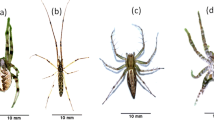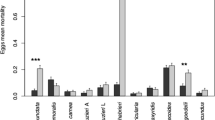Abstract
Present study was designed to assess the prey preference behaviour of three most dominant hunting spiders [Lycosa terrestris Butt, Anwar and Tahir 2006 (Araneae: Lycosidae), Pardosa birmanica Siman 1884 (Araneae: Lycosidae) and Oxyopes javanus (Thorell 1887) (Araneae: Oxyopidae)] of rice ecosystems both in the laboratory and in the field. Two types of laboratory experiments, i.e., choice and no choice feeding, were performed using only adult male and female specimens of the spiders. No choice test showed that each of the three hunting spiders readily consumed larvae and nymphs of rice pests offered. Female hunting spiders consumed more prey compared to male hunting spiders. Results of choice feeding test indicated that L. terrestris and P. birmanica preferred nymphs of rice insect pests while O. javanus preferred larvae of rice insect pests. Results of direct observations showed that in August, dipterous insects were the most numerous rice pests consumed by L. terrestris, P. birmanica and O. javanus, comprising over 56.3, 38 and 48% of their respective diets. In contrast, in September, the proportion of dipterous insects decreased dramatically and hoppers become the most numerous pests, comprising over 50, 51 and 41% of all prey and spiders consumed by L. terrestris, P. birmanica and O. javanus, respectively. In October, aquatic Heteroptera were frequently observed in their diets. Predatory potential of these hunting spiders differed statistically in the laboratory as well as in the field. It is concluded from the results of present project that studied species of spiders could successfully be used to control insect pests of rice ecosystems.



Similar content being viewed by others
References
Belovsky GE, Blade JB, Chase JM (1990) Mating strategies based on foraging ability: an experiment with grasshoppers. Behav Ecol 7:438–444. doi:10.1093/beheco/7.4.438
Hanna R, Zalom GF, Roltsch JW (2003) Relative impact of spider predation cover crop on population dynamics of Erythroneura variabilis in a raisin grape vine-yard. Entomol Exp Appl 107:109–116. doi:10.1046/j.1570-7458.2003.00051.x
Harwood JD, Sunderland DK, Symondson CO (2001) Living where the food is: web location by linyphiid spiders in relation to prey availability in winter wheat. J Appl Ecol 38:88–99. doi:10.1046/j.1365-2664.2001.00572.x
Hashmi AA (1994) Insect pest of paddy crops. IPM of cereals and cash crop, pp 1–59. http://www.parc.gov.pk/Respubs/Ipep.doc
Hayes LJ, Lockely CT (1990) Prey and nocturnal activity of wolf spiders (Araneae: Lycosidae) in cotton fields in the delta region of Mississippi. Environ Entomol 19:1512–1518
Ishijima C, Motobayshi T, Nakai M, Kunimi Y (2004) Impact of tillage practices on hoppers and predatory wolf spiders (Araneae: Lycosidae) in rice paddies. Appl Entomol Zool (Jpn) 39:155–162. doi:10.1303/aez.2004.155
Ito y, Miyashita K, Sekiguchik H (1962) Studies on the predators of the rice crop insect pests, using the insecticidal check method. Jpn J Ecol 12:1–12
Jackson RR, Pollard SD (1996) Predatory behavior of jumping spiders. Annu Rev Entomol 41:287–308. doi:10.1146/annurev.en.41.010196.001443
Jalaluddin SM, Mohan R, Velusamy R, Sadakathulla S (2000) Predatory behaviour in rice varieties under sodic soil conditions. Entomology 25:347–350
Kawahara S, Kiritani K, Kakiya N (1974) Population biology of Lycosa pseudoannulata (Bös. et Str.). Bull Kochi Inst Agric For Sci 6:7–22
Kim JP, Kim JC (1995) Influence of the levee and paddy burning on the fauna of overwintering spider. Kor Arachnol 11(2):59–71
Kiritani K, Hokyo N, Sasaba T, Nakasuji F (1970) Studies on population dynamics of green rice leafhopper, Nephotettix cincticeps Uhler: regulatory mechanism of the population density. Res Popul Ecol (Kyoto) 12:137–153. doi:10.1007/BF02511560
Landis DA, Wratten SD, Gurr GM (2000) Habitat management to conserve natural enemies of arthropod pests in agriculture. Annu Rev Entomol 45:175–201. doi:10.1146/annurev.ento.45.1.175
Lang A, Filser J, Henschel JR (1999) Predation by ground beetles and wolf spiders on herbivorous insects in a maize crop. Agric Ecosyst Environ 72:189–199. doi:10.1016/S0167-8809(98)00186-8
Marc P, Canard A, Ysnel F (1999) Spiders (Araneae) useful for pest limitation and bioindication. Agric Ecosyst Environ 74:229–273. doi:10.1016/S0167-8809(99)00038-9
Motobayashi T, Ishijima C, Takaji M, Murakami M, Tacguchi A, Hidaka K, Kunimi Y (2006) Impact of tillage practices on spiders assemblages in rice paddy fields. Appl Entomol Zool (Jpn) 41:371–381. doi:10.1303/aez.2006.371
Nentwig W, Wissel C (1986) A comparison of prey lengths among spiders. Oecologia 68:595–600. doi:10.1007/BF00378777
Nyffeler M (2000) Do adult female lycosids feed during the period of maternal care. Bull Br Arachnol Soc 11:388–390
Nyffeler M (1982) Field studies on the ecological role of spiders as insect predators in agroecosystems (abandoned grassland, meadows, and cereal fields). Ph.D Thesis, Swiss Federal Institute of Technology, Zürich
Nyffeler M, Benz G (1988) Prey and predatory importance of micryphantid spiders in winter wheat. J Appl Entomol 105:190–197
Nyffeler M, Benz G (1987) Spiders in natural pest control: a review. J Appl Ent 103:321–339
Nyffeler M, Sunderland DK (2003) Composition, abundance and pest control potential of spider communities in agroecosystem. A comparison of European and U.S. studies. Agric Ecosyst Environ 95:579–612. doi:10.1016/S0167-8809(02)00181-0
Nyffeler M, Sterling WL, Dean DA (1994a) How spiders make a living. Environ Entomol 23:1357–1367
Nyffeler M, Sterling WL, Dean DA (1994b) Insectivorous activities of spiders in United States field crops. J Appl Entomol 118:113–128
Oedekoven MA, Joern A (2000) Plant quality and spider predation affects grasshoppers (Acrididae): food quality-dependant compensatory mortality. Ecology 81:66–77
Oedekoven MA, Joem A (1998) Stage based mortality of grassland grasshoppers (Acrididae) from wandering spider (Lycosidae) predation. Acta Oecol 19:507–515. doi:10.1016/S1146-609X(99)80005-8
Oraze MJ, Grigarick AA (1989) Biological control of aster leafhopper (Homoptera: Cicadellidae) and midges (Diptera: Chironomidae) by Pardosa ramulosa (Araneae: Lycosidae) in California rice fields. J Econ Entomol 82:745–749
Pearce S, Hebron WM, Raven RJ, Zalucki MP, Hassan E (2004) Spider fauna of Soyabean crop in south-east Queensland and their potential as predator of Helicoverpa spp. (Lepidoptera: Noctuidae). Aust J Entomol 43:57–65. doi:10.1111/j.1440-6055.2003.00378.x
Pearce S, Zalucki MP (2006) Do predators aggregate in response to pest density in agroecosystem? Assessing within-field spatial patterns. J Appl Ecol 43:128–140. doi:10.1111/j.1365-2664.2005.01118.x
Pedigo LP (2001) Entomology and pest management, 4th edn. Prentice Hall, New Jersey, p 234
Pfiffner L, Wyss E (2004) Sown wildflower strips to enhance natural enemies of agricultural pests in annual and perennial cropping system. In: Gurr GM, Wratten SD, Altier MA (eds) Ecological engineering for pest management: advances in habitat manipulation for arthropods. CSIRO Press, Collingwood, pp 165–186
Riechert SE (1999) The hows and whys of successful pest suppression by spiders: insights from case studies. J Arachnol 27:387–396
Riechert SE, Bishop L (1990) Prey control by an assemblage of generalist predators: spiders in garden test systems. Ecology 71:1441–1450. doi:10.2307/1938281
Riechert SE, Lockley T (1984) Spiders as biological control agents. Annu Rev Entomol 29:299–320. doi:10.1146/annurev.en.29.010184.001503
Roschewitz I, Thies C, Tscharntke T (2005) Are landscape complexity and farm specialization related to land-use intensity of annual fields? Agric Ecosyst Environ 105:87–99. doi:10.1016/j.agee.2004.05.010
Schmidt MH, Thies C, Tscharntke T (2004) Landscape context of arthropod biological control. In: Gurr GM, Wratten SD, Altier MA (eds) Ecological engineering for pest management: advances in habitat manipulation for arthropods. CSIRO Press, Collingwood, pp 55–63
Sebastian AP, Mathew JM, Pathummal BS, Joseph J, Biju RC (2005) The spider fauna of the irrigated rice ecosystem in the central Kerala, India. J Arachnol 33:247–255396. doi:10.1636/05-08.1
Settle WH, Ariawan H, Astuti E, Cahyana W, Hakim AL, Hindayana D, Lestari AS, Pajarningsih S (1996) Managing tropical rice pests through conservation of generalist natural enemies and alternative prey. Ecology 77(7):1975–1988. doi:10.2307/2265694
Synder WE, Wise DH (1999) Predator interference and the establishment of generalist predator populations for biocontrol. Biol Control 15:283–292. doi:10.1006/bcon.1999.0723
Tahir MH, Butt A (2008) Activities of spiders in rice fields of central Punjab, Pakistan. Acta Zool Sin 54(4):701–711
Takashi M, Chikara I, Motonori T, Mihoko M, Ayame T, Kazumasa H, Yasuhisa K (2006) Effects of tillage practices on spider assemblage in rice paddy fields. Appl Entomol Zool (Jpn) 41(2):371–381. doi:10.1303/aez.2006.371
Turnbull AL (1960) The prey of the spider Linyphia triangularis (Clerck) (Araneae: Linyphiidae). Can J Zool 38:859–873. doi:10.1139/z60-091
Uetz GW (1990) Prey selection in web-building spiders and evolution of prey defenses. In: Evans DL, Schmidt OJ (eds) Insect defense. Adaptive mechanisms and strategies of prey and predators. University of New Yark Press, Albeny, pp 93–128
Van den Bosch R, Messenger PS, Gutierrez AP (1982) An introduction to biological control. Plenum Press, New York, p 247
Walker ES, Rypstra LA (2001) Sexual dimorphism in functional response and troph morphology in Rabidosa rabida (Araneae: Lycosidae). Am Midl Nat 146:161–170. doi:10.1674/0003-0031(2001)146[0161:SDIFRA]2.0.CO;2
Wise DH (1993) Spiders in ecological webs. Cambridge University Press, Cambridge, p 328
Xu JS, Chen ZF, Zhu RL (1987) Study and application of spiders in rice fields in Zhejiang Province. Nat Enemy 9(1):140–144
Ye ZX, Wang DD (1987) Population dynamics of spiders in rice fields of Jiangxi Province. Bull Biol Control 3(1):11–14
Author information
Authors and Affiliations
Corresponding author
Additional information
Communicated by J. R. Bell.
Rights and permissions
About this article
Cite this article
Tahir, H.M., Butt, A. Predatory potential of three hunting spiders inhabiting the rice ecosystems. J Pest Sci 82, 217–225 (2009). https://doi.org/10.1007/s10340-008-0242-9
Received:
Revised:
Accepted:
Published:
Issue Date:
DOI: https://doi.org/10.1007/s10340-008-0242-9




